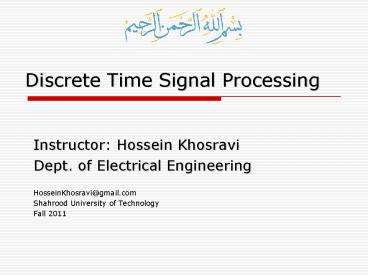Discrete Time Signal Processing - PowerPoint PPT Presentation
1 / 15
Title:
Discrete Time Signal Processing
Description:
Discrete Time Signal Processing Instructor: Hossein Khosravi Dept. of Electrical Engineering HosseinKhosravi_at_gmail.com Shahrood University of Technology – PowerPoint PPT presentation
Number of Views:93
Avg rating:3.0/5.0
Title: Discrete Time Signal Processing
1
Discrete Time Signal Processing
- Instructor Hossein Khosravi
- Dept. of Electrical Engineering
- HosseinKhosravi_at_gmail.com
- Shahrood University of Technology
- Fall 2011
2
Course Details
- Objective
- Establish a background in Digital Signal
Processing Theory - Design and implementation of DSP algorithms using
MATLAB. - Required Text
- Discrete-Time Signal Processing,
- Prentice Hall, 2nd Edition
- Alan Oppenheim, Ronald Schafer, John Buck
- Grading
- Attendance
- Assignment
- Project
- Midterm Exam
- Final Exam
3
Where is DSP
4
DSP is Everywhere
- Sound applications
- Compression, enhancement, special effects,
synthesis, recognition, echo cancellation, - Cell Phones, MP3 Players, Movies, Dictation,
Text-to-speech, - Communication
- Modulation, coding, detection, equalization, echo
cancellation, - Cell Phones, dial-up modem, DSL modem, Satellite
Receiver, - Automotive
- ABS, GPS, Active Noise Cancellation, Cruise
Control, Parking,
5
DSP Application
- Medical
- Magnetic Resonance, Tomography,
Electrocardiogram, - Military
- Radar, Sonar, Space photographs, remote sensing,
- Image and Video Applications
- DVD, JPEG, Movie special effects, video
conferencing, - Mechanical
- Motor control, process control, oil and mineral
prospecting,
6
Course Outline
- Topic 1 Discrete-Time Signals and Systems
- Topic 2 The Z-Transform
- Topic 3 Sampling of Continuous Time Signals
- Topic 4 Transform Analysis of Linear
Time-Invariant Systems - Topic 5 Structures of Discrete-Time Systems
7
Outline
- Topic 6 Filter Design Techniques
- Topic 7 The Discrete Fourier Transform (DFT)
- Topic 8 Computation of the Discrete Fourier
Transform - Topic 9 Applications of Digital Signal
Processing
8
Signal Processing
- Humans are the most advanced signal processors
- speech and pattern recognition, speech
synthesis, - We encounter many types of signals in various
applications - Electrical signals voltage, current, magnetic
and electric fields, - Mechanical signals velocity, force,
displacement, - Acoustic signals sound, vibration,
- Other signals pressure, temperature,
9
Signal Processing
- Most real-world signals are analog
- They are continuous in time and amplitude
- Convert to voltage or currents using sensors and
transducers - Analog circuits process these signals using
- Resistors, Capacitors, Inductors, Amplifiers,
- Analog signal processing examples
- Audio processing in FM radios
- Video processing in traditional TV sets
10
Limitations of Analog Signal Processing
- Accuracy limitations due to
- Component tolerances
- Undesired nonlinearities
- Limited repeatability due to
- Tolerances
- Changes in environmental conditions
- Temperature
- Vibration
11
Limitations of Analog Signal Processing (cntd)
- Sensitivity to electrical noise
- Inflexibility to changes
- Limited dynamic range for voltage and currents
- Difficulty of implementing certain operations
- Nonlinear operations
- Time-varying operations
- Difficulty of storing information
12
Digital Signal Processing
- Represent signals by a sequence of numbers
- Sampling or analog-to-digital conversions
- Perform processing on these numbers with a
digital processor - Digital signal processing
- Reconstruct analog signal from processed numbers
- Reconstruction or digital-to-analog conversion
13
- Analog input analog output
- Tape Recording of music
- Analog input digital output
- Digital Thermometer
- Digital input analog output
- Text to speech
- Digital input digital output
- Compression of a file on computer
14
Advantages and Disadvantages of Digital Signal
Processing
- Advantages
- Accuracy can be controlled by choosing word
length - Repeatable
- Sensitivity to electrical noise is minimal
- Dynamic range can be controlled using floating
point numbers - Flexibility can be achieved with software
implementations - Non-linear and time-varying operations are easier
to implement - Digital storage is cheap
- Digital information can be encrypted for security
- Price/performance and reduced time-to-market
15
Advantages and Disadvantages of Digital Signal
Processing (cntd)
- Disadvantages
- Sampling causes loss of information
- A/D and D/A requires mixed-signal hardware
- Limited speed of processors
- Quantization and round-off errors

